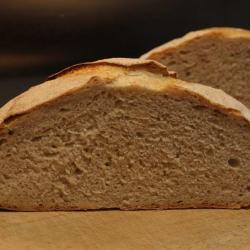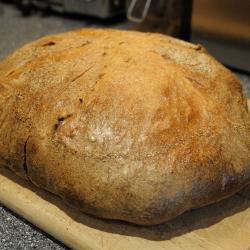
I'm a beginner having made just 3 sourdough loaves thus far. I've been following the excellent guide here: sourdough.com/blog/sourdom/beginners-blog-slash-and-burn-hopefully-not. My first two loaves didn't rise much so I used an oven stone (granite worktop saver from Wilkinsons) for my third attempt. It has come out much better, actually having an oven spring this time. My starter is from white flour, has been going three weeks, and is pretty active so I think that bit is ok. Here is the recipe I used:
180g Starter
320g Water
425g Strong White Bread Flour (organic)
75g Rye Flour (organic)
10g Salt
My question is, how do I get larger air pockets in the bread? Mine seems to have a finer texture than I'd like! I've attached a couple of pictures so you can see what I mean. Any advice/suggestions would be really appreciated...


4th Loaf
Here's how it turned out after trying again, following SourDom's recipe as closely as possible:


The texture is better this time and overall this is my best one so far. Having said that, the external shape and appearance isn't as nice as the last one. It flattened out quite a bit whilst getting it onto the baking stone so I'll try to do that quicker/better next time. Previously, I used a pan of water in the oven but this time I tried spraying it. This doesn't seem to have produced as nice a finish to the surface as I was getting previously. I will revert to the pan/steam method next time.



Replies
I have been baking sour dough bread for a few years now and i find to get a more open texture you need to mix the dough less.
It might not be relevant, but I notice that you have used rye flour rather than the wholemeal that SourDom has in his pane francesa recipe. Plus you use 75g rather than 50g.
Two possibilities then.
First, try the recipe exactly as specified by SourDom and see if it makes a difference.
Second, if you continue with this proportion and type of flours try a slightly higher hydration - maybe an extra 10 g or 15g of water. I find that if I double the proportion of wholemeal (100g), I can use 350g of water so my suggestion is based on this observation.
Let us know how you go.
Farinam
Hello Panesardo,
Wholemeal flour includes all elements of the grain - bran, germ and endosperm (mostly starch). On that basis it is generally deemed to be more healthful because of the fibre content as well as other nutritional factors. As a result of containing the bran particularly, weight for weight, wholemeal flour will absorb more water and thus makes a stiffer dough at a similar hydration.
White flour, on the other hand has the bran and germ removed and so consists largely of the starches contained in the endosperm. Sometimes the flour is chemically treated (bleached) to produce a whiter (more attractive??) product. In some cases nutritional elements such as vitamins are added back to improve the dietary intake in areas where these are considered to be lacking as a result of the removal of the bran and germ.
I think it is generally considered that bread containing at least some wholmeal component of flour is beneficial to your health and the taste of the bread is also better than one made with only white flour.
Good luck with your projects.
Farinam
Thank you both for your suggestions.
I actually hadn't realised that I'd varied from SourDom's recipe so much. I'd also read another guide which used Rye flour and have obviously mixed them up. That guide had suggested that if the dough was too sticky to work with then the percentage of Rye flour could be increased to help counter this. My first attempt was indeed very sticky hence increasing to 75g instead of 50g.
Still, that's no excuse; I'm pleased you pointed this out. I will try again this weekend with wholemeal instead of rye and follow the original proportions. Fingers crossed! Will let you know how it comes out....
Cheers
Dan
Hi Dan
Was it sticky through the whole dough preparation process or just at the beginning?
The dough is normally sticky at the start but that disappears as the gluten develops so you have to resist the temptation to add more flour. Short sharp contacts with the hands/bench will minimise the amount that sticks during kneading/folding until the gluten does develop. At worst, just dip your hands in flour if the sticking is too much for you.
My experience with rye flour is limited but I think it makes a 'stickier' dough than wheat flour though the proportion in your loaf was relatively low. It also requires a higher hydration when you get into really high rye content. I have heard of doughs at 100% hydration for pure rye. The loaves have to be tinned though.
Keep practicing, don't panic and it will all come good in time.
Farinam
It was indeed most sticky at the beginning but still at the end it had stuck to bowl. Hence my thinking it needed more more flour. With hindsight, I just didn't know what it should be like, nor how to handle it. I'm pretty sure now that the dough for this last loaf was way too stiff from the beginning. That made it easier to work with and shape, but didn't produce the texture I want. Next time I'll expect a looser dough and be prepared for perhaps needing more proving/folding cycles to make it more readily shapeable...
I've posted pictures and observations of my latest loaf in my original post above.
Here is my latest attempt using SourDom's original recipe. It has a more open texture than the last one which must be due to one or more of the following differences.
1) This time I mixed the starter with the water first before then mixing in the flour and salt. The guide does say to do this but I'd missed this detail before (previously added everything together then mixed). Not sure whether this makes much difference though.
2) I suspected that I might have over proved the previous loaves. I therefore gave this loaf one less rest/fold cycle before shaping, then one hour less rising time before baking (3 hours instead of 4 previously).
3) I turned out the dough directly onto the hot baking stone this time. Previously I'd turned it out onto a floured baking sheet then transferred it onto the stone. This definitely worked better this time. It was much quicker and the dough retained it's shape better than previously when it had spread out during the transfer process.
That's it, I'm not expecting any responses. I just thought I'd share my findings in case they're of any help to other beginners. I'm pretty happy with this latest result so will continue with this method to prove consistency etc...
To get a open textured bread,
- medium gluten flour ( about 11% of protein )
- more water
- less mixing
- longer fermentation time at a low temperature
- gentle shaping ( less losing gas bubbles )
may help you.
make a wet dough its more work but well worth the effort.
try using the turning method during the proving time.
Thanks for those tips. The first comment from fread_johnson also suggested mixing less so I've been trying to keep this to the bare minimum.
I've just checked my flour and it's 12.9% protein! Does this fall into the "medium gluten" range? 2% doesn't sound much different but if this is significant then I'll try to find another one nearer your 11% recomendation.
I've been trying to stick to the recipe thus far so haven't wanted to change the hydration etc. I was pretty happy with the last loaf so want to make sure that I can replicate this consistently first. I will then try experimenting with your suggestions for water and fermentation.
Any observations about my last picture? Are there any obvious faults or aspects that I could improve upon?
Cheers
Dan
Pastry flour contains about 10% of protein ,while bread flour (strong flour ) has 13% of protein.
Your flour seems to be strong flour which is used for making high gluten development breads such as pan breads.
If you change to lower protein flour then you may not need to add more water because less protein flour get less water. This means your dough would be soft same as adding more water on to strong flour.
I think your last bread is excellent. Just try another flour as holding on other factors.
Very interesting. I will get some lower protein flour and try again this weekend.
Thanks so much for your advice. This website is a goldmine of useful information and I'm extremely grateful to everyone who has commented on my post...
Cheers
Dan
Wetter dough, no "punch down", lots of folds and be very gentle when shaping - dont knead/shape the air out of it :)